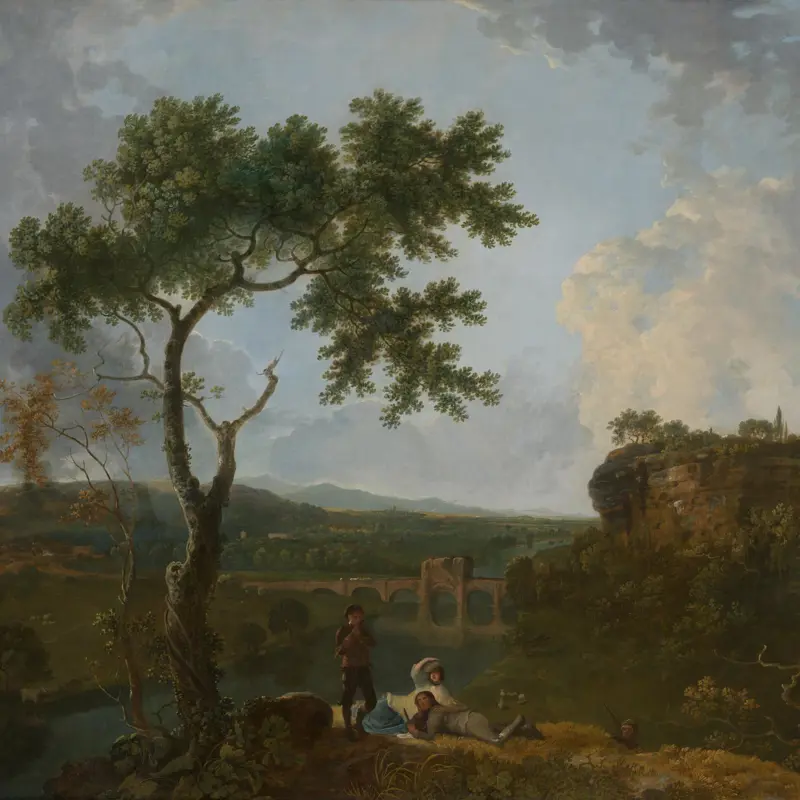Richard Wilson, 'The Valley of the Dee, with Chester in the Distance', about 1761
About the work
Overview
Like its pair Holt Bridge on the River Dee, which is also in the National Gallery, this is a view of the valley where England and Wales meet. It is probably the ‘View near Chester’ that Wilson exhibited at the Society of Artists in 1761. It was most likely painted downstream from the village of Holt in Denbighshire in North Wales, from a viewpoint five miles to the east of Gresford. The towers of Chester Cathedral and St John’s Church are just visible in the background. The hills in the distance may be in Lancashire, beyond the River Mersey. Wales is on the left of the river and England is on the right.
The style of the landscape is inspired by the work of the seventeenth-century French neoclassical painter, Claude, who depicted views of the countryside outside Rome. His paintings were very fashionable in Britain when Wilson painted this landscape.
Key facts
Details
- Full title
- The Valley of the Dee, with Chester in the Distance
- Artist
- Richard Wilson
- Artist dates
- 1713/14 - 1782
- Date made
- About 1761
- Medium and support
- Oil on canvas
- Dimensions
- 148 × 193.5 cm
- Acquisition credit
- Bought, 1953
- Inventory number
- NG6197
- Location
- Room 34
- Collection
- Main Collection
- Frame
- 19th-century Replica Frame
Provenance
Additional information
Text extracted from the ‘Provenance’ section of the catalogue entry in Judy Egerton, ‘National Gallery Catalogues: The British Paintings’, London 2000; for further information, see the full catalogue entry.
Exhibition history
-
2012Loan to Anglesey AbbeyAnglesey Abbey (The National Trust)14 March 2012 - 5 June 2012
-
2012Seduced by Art: Photography Past and PresentCaixaForum Barcelona21 February 2013 - 19 May 2013CaixaForum Madrid19 June 2013 - 15 September 2013
Bibliography
-
1841British Institution, Catalogue of Pictures by Italian, Spanish, Flemish, Dutch, and French Masters, with which the Proprietors have Favoured the Institution, London 1841
-
1955The National Gallery, The National Gallery: 1938-1954, London 1955
-
1959Davies, Martin, National Gallery Catalogues: British School, 2nd edn (revised), London 1959
-
2000Egerton, Judy, National Gallery Catalogues: The British Paintings, revised edn, London 2000
-
2001
C. Baker and T. Henry, The National Gallery: Complete Illustrated Catalogue, London 2001
Frame
Dating from the end of the eighteenth century to the early nineteenth century, this English frame is in the style of the ‘Carlo Maratta’ frame, named after the Roman artist Carlo Maratta (1625–1713). The frame is made from pinewood and is partially water- and oil-gilt. The back edge is decorated with an acanthus-leaf design and the outward-curving top is adorned with a ribbon-and-stick motif. The deep central hollow is embellished with acanthus leaves and shields. There is cabochon (egg-and-nest) motif near the sight edge.
This is one of a pair of frames that were crafted for two paintings by Richard Wilson.
About this record
If you know more about this work or have spotted an error, please contact us. Please note that exhibition histories are listed from 2009 onwards. Bibliographies may not be complete; more comprehensive information is available in the National Gallery Library.

